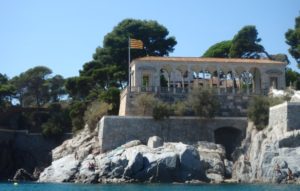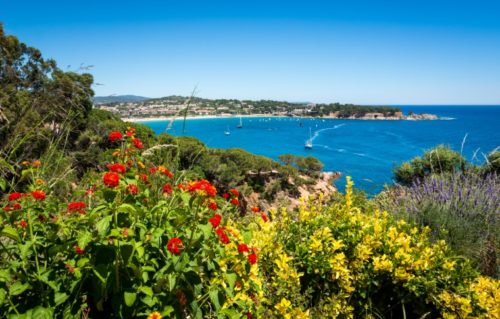
The Magical Coastline of La Costa Brava
The Costa Brava (meaning ‘wild’ or ‘rough coast’) is a coastal region of northeastern Spain, consisting of Alt Empordà, Baix Empordà, and Selva, in the province of Girona. The Costa Brava stretches from Blanes, 60 km (37 mi) northeast of Barcelona, to the French border.
In the 1950s, the Costa Brava was identified by the Spanish government and local entrepreneurs as being suitable for substantial development as a holiday destination. The combination of a very attractive summer climate, a wonderful variety of nature, excellent beaches, and a favourable foreign exchange rate, made this region in Spain a relatively inexpensive tourist destination.
The coast was named Costa Brava by Ferran Agulló (in Catalan, Ferran Agulló i Vidal) in an article published in the Catalan newspaper La Veu de Catalunya in September 1908. Agulló, a journalist born in Girona, referred to the rugged landscape of the Mediterranean coast which runs from the River Tordera, near Blanes, to Banyuls with the name Costa Brava. The term Costa Brava was officially recognised and promoted in the 1960s as it was deemed suitable to promote tourism in the region.

It may or may not be a coincidence that the name Costa Brava resembles Costa Blava (the Catalan designation of the French Riviera), which is a literal translation of the Spanish Costa Azul (“Blue Coast”). This, in turn, is a not-quite-literal translation of the French Côte d’Azur (“Azure Coast”); azul has the same etymology as azur, but it is the general Spanish term for blue, not specifically azure. A direct translation from French to Catalan would have yielded Costa d’Atzur.
Further south, following a stretch of beach and marshlands, are the towns of Pals, Begur, and Palafrugell. At this point, the Gavarres Massif meets the sea, with a coast marked by rugged cliffs, small bays, and beaches amid coastal villages such as Aiguafreda, Fornells, Tamariu, Calella de Palafrugell, and Llafranc. The town of Palamós, further south, is a major commercial and fishing port. At this point, the coast forms a bay between Palamós and Sant Antoni de Calonge, part of the town of Calonge. South of it lies the town of Castell-Platja d’Aro, including Platja d’Aro, a large tourist resort which has grown along a wide beach. Situated to the south are S’Agaró and the town of Sant Feliu de Guixols, which lies to the north-east of the Ardenya Massif.

History
After the First World War, the beaches along the coast of Catalonia served for Sunday leisure pursuits for the local people, plus one or two from neighbouring villages. While world tourism had discovered the Côte d’Azur by that time, the Costa Brava continued to remain unknown.
A few years after the Spanish Civil War, when some sort of order had been restored, the gradual breaking down of Spain’s international isolation in the 1950s cleared the way for new options in tourism. The sea and the sun were drawing increasing numbers of people, and that, together with the overcrowding the Côte d’Azur was already experiencing in those days, enhanced the appeal of the Costa Brava when some of the holiday-makers made their way up there.
Environmental Protection
In 1998, the coastal towns of the Costa Brava signed a charter called the Carta de Tossa, which undertook to pursue environmental protection, along with tourism. This recognised the value of the region’s wide range of natural habitats and microclimates. The Medes Islands off the coast of L’Estartit are in Spain’s first marine reserve and provide a home to a wide range of fish and aquatic flora and fauna. The nearby wildfowl reserve on marshlands at Aiguamolls de l’Empordà also saved the land from the potential ravages of development.
Culture
While part of the Costa Brava coastline lent itself to tourist developments on a very large scale, other parts have retained a more traditional look. Small towns like Cadaqués, which is close to the French border and close to the foothills of the Pyrenees, have attracted artists, such as Salvador Dalí, Joan Miró, and Pablo Picasso. The Dalí Theatre and Museum in Figueres is one of the most important and visited museums in Catalonia. One can also visit Dalí’s House-Museum in Port Lligat, near Cadaqués and the castle of Púbol in Púbol. Our famous Kayaking and Snorkeling tour is run in the town of Sant Feliu de Guixols and S’Agaró, which are located on the Costa Brava.

Sant Feliu De Guíxols

Sant Feliu de Guíxols is a municipality in the comarca of the Baix Empordà in Catalonia, Spain. It is situated on the Costa Brava and is an important port and tourist centre. The district borders to the north, the upmarket s’Agaró resort built around the Sant Pol Beach. In addition to tourism and the port, the cork industry is a traditional local industry. The town contains a large monastery that now houses the town museum and is a protected historic-artistic monument.
Sant Feliu De Guíxols was once the most popular location in the counties of Girona for cinema producers and the second-most popular in all of Catalonia (after Barcelona). These results are logical enough: the Costa Brava is a potent area full of beauty and diversity, located close to the historical city of Girona with an old quarter that holds a huge amount of visual possibilities.
On our famous Kayaking and Snorkeling tour, we’ll visit the beautiful town of Sant Feliu de Guixols and S’Agarówhich on the Costa Brava.
Geography and Climate
Located on the Mediterranean, Sant Feliu de Guíxols has idyllic weather almost all year long. The coastline of Sant Feliu de Guíxols spreads over ten kilometres (6.2 miles). It also includes many small bays with coves surrounded by pines and rocky or fine sand beaches. The beaches are cleaned daily and a modern water treatment system prevents wastewater from entering the sea. The town is engulfed by small mountains, with forests of pine, oak, and cork trees.
History
The original nucleus of the Town A township started to grow up on the basis of the various activities surrounding the Monestir de Sant Feliu de Guíxols. The settlement grew, and soon dwellings started to spring up on the other side of the watercourse, which would become the nucleus of the medieval town, centred on the market.
Etymology
The name Sant Feliu goes back to the martyred saint, Feliu, who came from Africa. Guíxols is a word derived from the former word Iecsalis, of a document from the 10th century that mentions the monastery and that seems to mean “ropemaker”.

S’Agaró

S’Agaró is an upmarket resort on the Costa Brava between Sant Feliu de Guíxols and Castell-Platja d’Aro in Catalonia. In the early 1920s, Josep Ensesa Gubert, the son of a successful Girona industrialist, persuaded his father to buy the land between the bay at Sant Pol and the long beach at Sa Conca north of Sant Feliu de Guixols. The area didn’t even have a name, so the family chose to call it after the Agaro stream that ran through it. Inhabited by squirrels and lizards, supervised by gulls that would inspire the inn’s name, the treeless scrub offered little but a gentle climate, splendid isolation, and dazzling views. Not to mention the intoxicating scent of pine trees mixed with aniseed plants that grew wild, even to this day. Josep Ensesa was (thankfully) determined that the mystic spirit of the place was not to be sacrificed to the demands of property development as the rest of the Costa Brava succumbed over the next eight decades to the present.

To ensure that the development (a community of seaside villas and a small inn) would be in harmony with the landscape, he turned to an architect, Rafael Masó i Valentí, an outspoken campaigner for traditional Catalan design. Mr Masó drew on the local architectural vocabulary of porticos, towers, terraces, and low rooflines to conjure a colony aimed at those with artistic tastes. Purchasers of land-bound themselves to carefully drawn contracts that guaranteed buildings of visual unity. After Masó’s death in 1935, Francesc Folguera took over the project, going on to build the church situated on the highest point of the resort.
To date, the promontory contains about 60 exclusive houses with part of the camí de ronda following S’Agaró’s coastline in its entirety.
The world-famous five star Hostal de la Gavina dominates the view from Sant Pol beach and was popular with movie stars such as Charles Chaplin, Orson Welles, Frank Sinatra, Ava Gardner, Bogart, and Bacall. Add to that Elizabeth Taylor, Joan Fontaine, Peter Sellers, John Wayne, Dirk Bogarde, and Sean Connery – without discounting that S’Agaró wasn’t merely Hollywood-by-the-Sea. Writers like Jean Cocteau rubbed shoulders with the soprano Teresa Berganza, the tenor José Carreras, Cole Porter, and political figures like ex-prime minister Edward Heath of Britain, Raymond Barre of France, Clare Boothe Luce, King Juan Carlos, as well as the finance ministers of the European Community.

